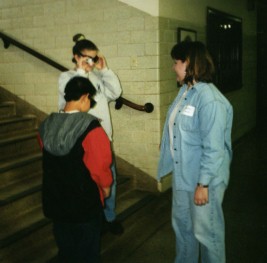
On April 6th and 8th the class visitedMrs. Kahn's seventh-grade life sciences class. Here we shared whatwe'd learned through short presentations, handouts created by thestudents, and interactive demonstrations with the seventh-graders.Below is a decription of what we did and several pictures from thedemonstrations.
After these presentations, we dividedinto groups so that each SFA student worked with about two TJRstudents. We had several sets of goggles which simulated the effectsof low acuity, glaucoma, cataracts, macular degeneration, andretinitous pigmentosa. Each TJR student took turns wearing thedifferent goggles while performing an everyday task such as readingthe bulletin board, walking down the hall, and getting a drink ofwater. They were all amazed how everyday activities become much moredifficult when there is some loss of vision!

Mandy Taylor watches two TJRstudents wearing goggles. The girl on the stairs has on a pair whichsimulate the reduced perceptual field of glacoma.
At this point, we had the SFA and TJRstudents pair up again and do several color demonstrations at thedesks: color after-effects, Ishihara color plates to test for colorblindness, colored-yarn matching with and without a yellow lens infront of their eyes (which simulated the yellowing of the variablelens seen in the aging human eye), and viewing pictures whichsimulate visual sceens as perceived by people with different types ofcolorblindness.
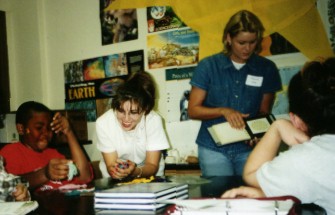
Toni Ray works with a studentwho is matching colored yarn while looking through a yellowtransparency. Julie Terry is using the Ishihara color plates to testa students' colorvision.
After these presentations we first playeda tape which simulated the effects of different levels of highfrequency hearing loss. We stressed that life-long exposure to sound,especially loud sounds (like through walkman headphones) could leadto such losses in older age.
Finally, we again had the studentsexperience interactive demonstrations in groups. There was a motionafter-effect spiral, stereoscopes which had figural and random-dotstereograms, a book with red-green stereograms and other illusions,the Pulfrich effect, goggles which inverted and displaced vision, andan active touch demonstration that was done both with and withoutgloves (to simulate loss of agility and touch receptors often seenwith aging).
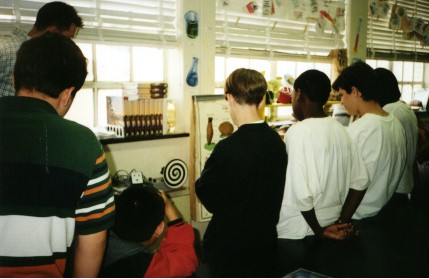
Erik Steen shows a group of TJRstudents the motion aftereffect demonstration.
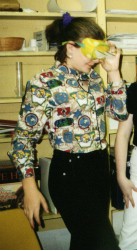
A TJR student experiences theworld upsidedown by wearing inverting prismgoggles.
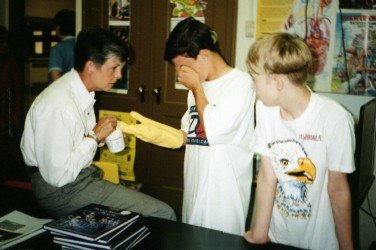
Glenda Demaree works with astudent who is wearing a glove to stimulate aging and who is tryingto recognize objects by only using the sense of touch.
Return to the1998 Perceptionfront page.